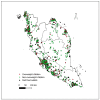Association between Availability of Neighborhood Fast Food Outlets and Overweight Among 5⁻18 Year-Old Children in Peninsular Malaysia: A Cross-Sectional Study
- PMID: 30781699
- PMCID: PMC6406246
- DOI: 10.3390/ijerph16040593
Association between Availability of Neighborhood Fast Food Outlets and Overweight Among 5⁻18 Year-Old Children in Peninsular Malaysia: A Cross-Sectional Study
Abstract
A growing number of fast-food outlets in close proximity to residential areas raises a question as to its impact on childhood overweight and obesity. This study aimed at determining the relationship between the availability of fast-food outlets that were in close proximity to residential areas and overweight among Malaysian children aged 5 to 18 years. Measurement data on the weight and height of 5544 children (2797 boys, 2747 girls) were obtained from the National Health and Morbidity Survey 2011. Overweight (including obesity) is defined as BMI-for-age z-score > +1 SD based on the WHO growth reference. Geographic information system geospatial analysis was performed to determine the number of fast-food outlets within 1000 m radius from the children's residential address. Multiple logistic regression was conducted to examine the association between the availability of fast-food outlets (none or more than one outlet) and overweight with adjustment for age, sex, ethnicity, monthly household income, parental educational level, residential area and supermarket density. Our results showed that the prevalence of overweight was 25.0% and there was a statistically significant association between the density of fast-food outlets and overweight (odds ratio: 1.23, 95% confidence interval: 1.03, 1.47). Our study suggested that the availability of fast-food outlets with close proximity in residential areas was significantly associated with being overweight among children. Limiting the number of fast-food outlets in residential areas could have a significant effect in reducing the prevalence of overweight among Malaysian children.
Keywords: children; fast food; geospatial analysis; overweight.
Conflict of interest statement
The authors declare no conflict of interest. The funders had no role in the design of the study; in the collection, analyses, or interpretation of data; in the writing of the manuscript, or in the decision to publish the results.
Figures
Similar articles
-
Association between Childhood Obesity and Neighbourhood Accessibility to Fast-Food Outlets: A Nationwide 6-Year Follow-Up Study of 944,487 Children.Obes Facts. 2017;10(6):559-568. doi: 10.1159/000481352. Epub 2017 Nov 22. Obes Facts. 2017. PMID: 29161708 Free PMC article.
-
Association between full service and fast food restaurant density, dietary intake and overweight/obesity among adults in Delhi, India.BMC Public Health. 2017 Jul 19;18(1):36. doi: 10.1186/s12889-017-4598-8. BMC Public Health. 2017. PMID: 28724371 Free PMC article.
-
Walkable home neighbourhood food environment and children's overweight and obesity: Proximity, density or price?Can J Public Health. 2016 Jun 9;107(Suppl 1):5347. doi: 10.17269/cjph.107.5347. Can J Public Health. 2016. PMID: 27281522 Free PMC article.
-
Correlates of English local government use of the planning system to regulate hot food takeaway outlets: a cross-sectional analysis.Int J Behav Nutr Phys Act. 2019 Dec 9;16(1):127. doi: 10.1186/s12966-019-0884-4. Int J Behav Nutr Phys Act. 2019. PMID: 31818307 Free PMC article. Review.
-
A cross-sectional study using the Childhood Measurement Programme for Wales to examine population-level risk factors associated with childhood obesity.Public Health Nutr. 2021 Aug;24(11):3428-3436. doi: 10.1017/S1368980020001913. Epub 2020 Aug 3. Public Health Nutr. 2021. PMID: 32744211 Free PMC article. Review.
Cited by
-
Fast food consumption among young adolescents aged 12-15 years in 54 low- and middle-income countries.Glob Health Action. 2020 Dec 31;13(1):1795438. doi: 10.1080/16549716.2020.1795438. Glob Health Action. 2020. PMID: 32762333 Free PMC article.
-
Prevalence of childhood overweight and obesity in Malaysia: a systematic review and meta-analysis.Clin Exp Pediatr. 2025 Feb;68(2):115-126. doi: 10.3345/cep.2024.00899. Epub 2024 Nov 13. Clin Exp Pediatr. 2025. PMID: 39533723 Free PMC article.
-
Childhood Obesity: A Narrative Review.Cureus. 2025 Apr 14;17(4):e82233. doi: 10.7759/cureus.82233. eCollection 2025 Apr. Cureus. 2025. PMID: 40231296 Free PMC article. Review.
-
Frequent Eating Out and 10-Year Cardiovascular Disease Risk: Evidence from a Community Observatory in Malaysia.Biomed Res Int. 2022 Mar 7;2022:2748382. doi: 10.1155/2022/2748382. eCollection 2022. Biomed Res Int. 2022. PMID: 35295957 Free PMC article.
-
Knowledge, Attitude and Practices of Sugar-Sweetened Beverages: A Cross-Sectional Study among Adolescents in Selangor, Malaysia.Nutrients. 2020 Nov 25;12(12):3617. doi: 10.3390/nu12123617. Nutrients. 2020. PMID: 33255585 Free PMC article.
References
-
- Institute for Public Health . National Health and Morbidity Survey 2011 (NHMS 2011). Non-Communicable Diseases. Insitute for Public Health, Ministry of Health; Kuala Lumpur, Malaysia: 2011.
-
- Institute for Public Health . National Health and Morbidity Survey 2015 (NHMS 2015): Non-Communicable Diseases, Risk Factors and Other Health Problems. Institute for Public Health; Kuala Lumpur, Malaysia: 2015.
-
- Ang Y.N., Wee B.S., Poh B.K., Ismail M.N. Multifactorial influences of childhood obesity. Curr. Obes. Rep. 2013;2:10–22. doi: 10.1007/s13679-012-0042-7. - DOI
Publication types
MeSH terms
LinkOut - more resources
Full Text Sources
Medical


